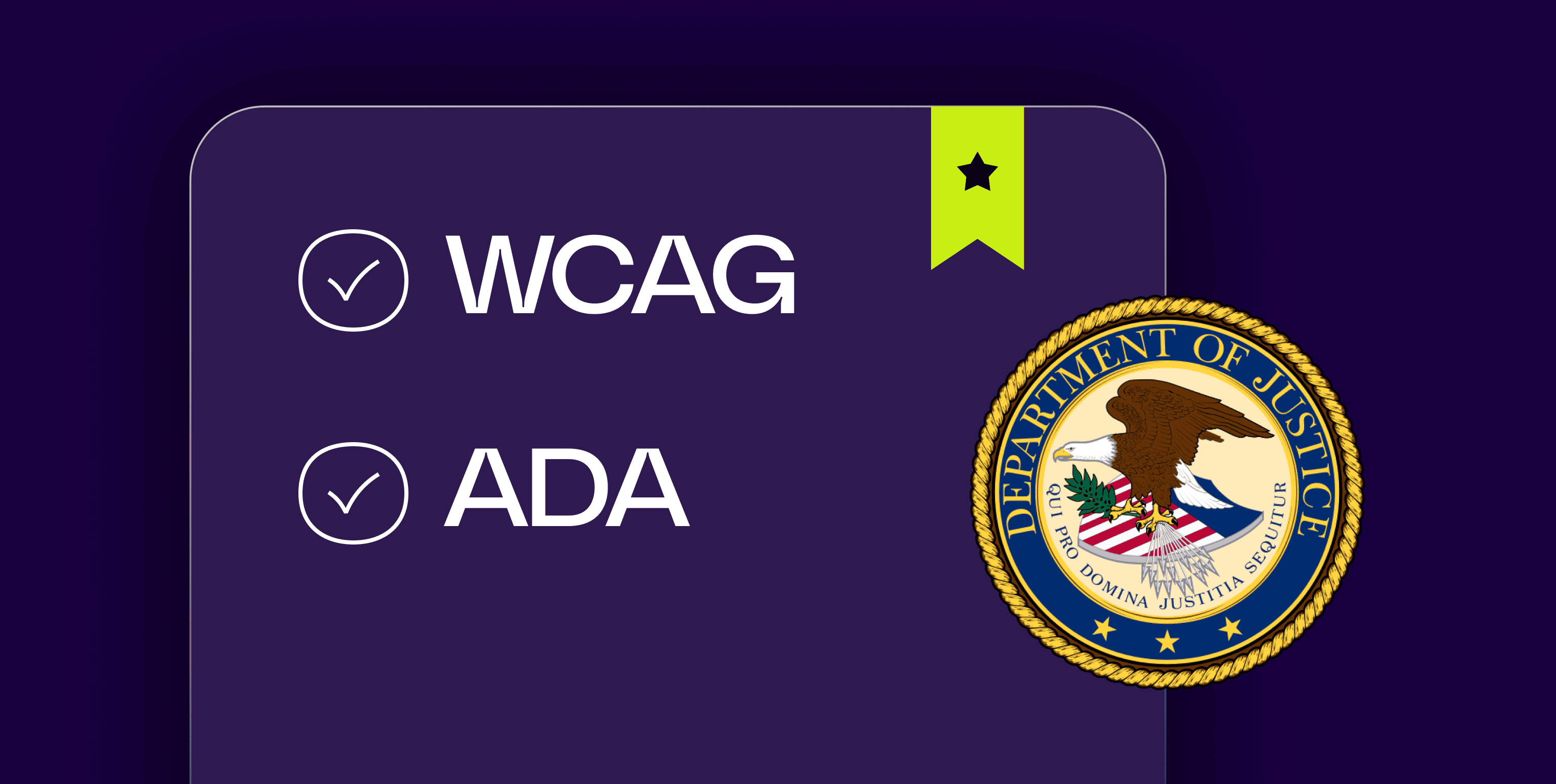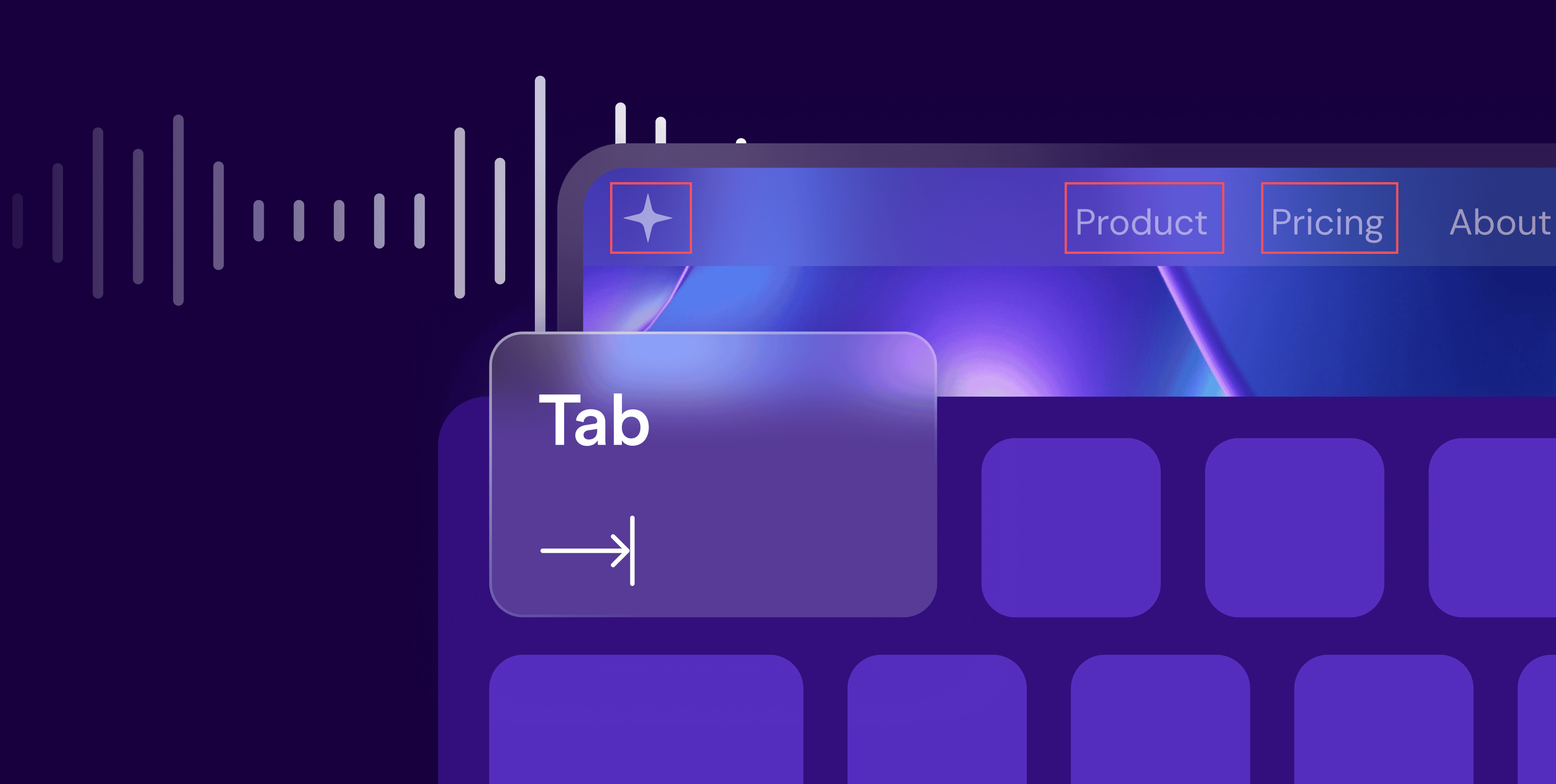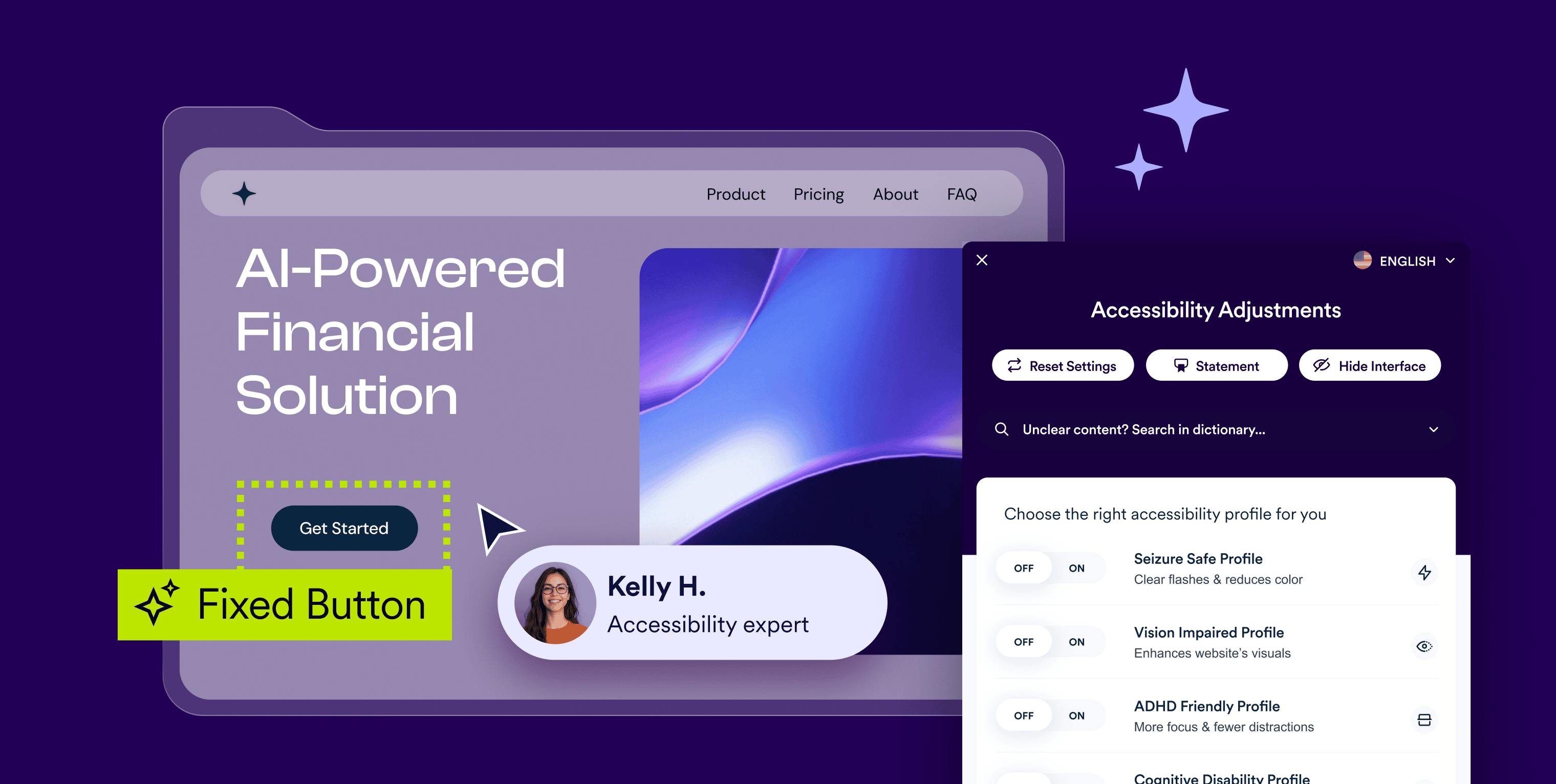The stat appearing in the image at the top of this blog is not a blip or an isolated trend; it’s a reflection of how online stores, more than any other digital property, are being penalized for accessibility barriers that prevent customers from browsing, buying, and completing transactions.
Why is this happening?
The answer lies in the nature of eCommerce itself: frequently updated and filled with dynamic elements like product filters, image carousels, popups, and multi-step checkouts, all of which can be difficult to make accessible without the right tools or oversight.
This blog breaks down why online stores are especially vulnerable, what the real-world consequences of inaccessibility look like, and what you can do now to make your online site more inclusive - and reduce your exposure to legal action.
The steep cost of inaccessibility
In 2024 alone, 77% of all web accessibility lawsuits in the U.S. targeted online retailers, making the industry the most litigated digital sector. Over 30% of the top 500 eCommerce retailers were sued last, and 82% have faced at least one digital lawsuit since 2018.*
Many of the businesses named in these lawsuits are among the most recognizable brands in American and global retail:
- Amazon was sued for assistive technology and Braille display incompatibility
- Domino’s Pizza, in a years-long legal battle, was ordered to make its site and app accessible
- Five Guys reached a settlement after being sued over an inaccessible website, agreeing to a remediation plan and coverage of legal fees
While national retailers tend to attract the headlines, regional and mid-market brands are regularly met with legal action for inaccessible digital environments, as well.
Prominent cases include:
- Dania Furniture, sued in 2024 over an inaccessible shopping experience. The court reaffirmed that retail websites — regardless of size — are subject to legal requirements
- Don Roberto Jewelers, a California-based retailer, successfully sued by a New York resident
Yet lawsuits are often just the final step in a broader pattern of legal enforcement.
Each year, hundreds of thousands of demand letters are sent to businesses over digital accessibility violations, with online retailers receiving a significant share*.
Being named in one of these letters signals that a business is excluding customers with disabilities, and the reputational consequences can be immediate and lasting.
The cost of inaccessibility goes beyond covering legal fees or settlements.
Brands risk eroding trust among both customers and the broader public, and forfeiting the loyalty of a global market representing trillions in annual disposable income.
What exactly are the legal requirements for online stores?

The law which online stores need to comply with, and the one under which most accessibility lawsuits are filed, is the Americans with Disabilities Act (ADA) - a civil rights law that prohibits discrimination against individuals with disabilities.
Title III of the ADA applies to “places of public accommodation,” a category that includes retail stores, restaurants, travel and hospitality facilities, senior care institutions, and most public-facing businesses.
Both the U.S. Department of Justice (DOJ) and federal courts have consistently applied the ADA to websites.
As a result, online stores, being inherently public-facing, are expected to provide accessible digital experiences in accordance with the ADA.
WCAG: The guiding document for ADA compliance
In legal cases involving web accessibility under the ADA, the Web Content Accessibility Guidelines (WCAG) are routinely cited by U.S. courts as the guiding document for ADA compliance. This reflects the DOJ’s position, which has been reaffirmed repeatedly over the years, most recently in 2024.
There are several versions of WCAG (2.0, 2.1, and 2.2) with each consisting of three levels of conformance: A, AA, and AAA. While Level A represents the minimum threshold, and AAA the most stringent, Level AA is the standard most commonly referenced in accessibility regulations and legal settlements.
Ultimately, for a website to be considered accessible under the ADA, it should conform to WCAG 2.1 Level AA.
In practice, this means ensuring that critical parts of the online shopping experience, such as navigation, forms, images, and interactive components, are operable, understandable, and perceivable by people with a range of disabilities.
To learn more about the specific requirements and how they apply to your site, we recommend reading: ADA compliance for eCommerce websites.
Why eCommerce sites face higher legal exposure

Online stores are filled with dynamic elements, such as product carousels, filters, image galleries, modals, popups, and third-party integrations.
When these components aren’t built with accessibility in mind, they often become unusable for people using assistive technologies. This includes screen readers, which convert on-screen content into speech, or those who rely on keyboard navigation, which allows them to operate a site without a mouse.
Unlike static content, these interactive elements often rely on complex JavaScript behaviors or custom code.
Without explicit markup (the underlying code that defines content structure) and proper ARIA attributes (accessibility tags that help assistive technologies understand interactive elements), screen readers can’t interpret their structure or purpose.
Similarly, keyboard users may find themselves unable to reach or operate these elements if tab order isn’t clearly defined, or if focus is lost during interaction.
These gaps become especially problematic in multi-step flows like checkout, login, or registration. If just one element in the sequence isn’t accessible, the process breaks down entirely.
Frequent updates only increase the likelihood of accessibility issues occurring.
eCommerce sites are in a constant state of change: new products are added, prices are adjusted, promotions launch and expire, and content is regularly swapped out to reflect sales cycles.
These updates often introduce new interactive elements or third-party components, which can easily disrupt accessibility if not implemented carefully.
Real-world examples of accessibility barriers disrupting the checkout experience for people with disabilities
To help illustrate the issue, here are two common scenarios in which people with certain disabilities may be prevented from completing a purchase on an inaccessible online store:
1. Unlabeled fields create barriers for people with vision impairments
Customers with vision impairments, including blindness and low vision, often rely on screen readers to complete online purchases. During checkout, screen readers depend on properly labeled form fields to announce what each input is for, like name, card number, or expiration date.
When those labels are missing or unclear, the screen reader provides no useful context; customers are left guessing what information to enter, and many abandon the checkout process as a result.
2. Broken keyboard navigation blocks users with motor disabilities
Customers with motor disabilities like cerebral palsy or muscular dystrophy rely on keyboard navigation and use the desktop version of your store to complete purchases.
If keyboard navigation isn’t properly supported, customers may be unable to reach required fields or buttons during checkout, and will likely abandon their cart before completing a purchase.
So, what can you do about it?

Accessibility calls for a strategic, long-term approach - and this is especially true for online stores. Store owners who are serious about transforming their sites so that they align with WCAG standards - and mitigate the legal risk they are exposed to - should invest in comprehensive accessibility solutions, like those offered by accessiBe.
1. Leverage the power of AI
Integrating seamlessly with every major eCommerce CMS and site building platform, accessiBe’s AI-powered solution accessWidget quickly audits your site, automatically remediating the accessibility issues it finds. This results in your store becoming screen reader compatible and navigable via keyboard, in adherence to WCAG 2.1 Level AA.
Additionally, accessWidget presents your shoppers with an interface through which they can adjust the look and feel of your store to better fit their needs:
People with cognitive disabilities like ADHD can stop animations and other distracting elements, while people with vision impairments can adjust color contrasts, increase text size, select more legible fonts, and more.
Whether you rely on Shopify, WooCommerce, BigCommerce, Squarespace, or another prominent eCommerce site building platform, accessWidget easily integrates into your existing setup, helping you on your way to legal compliance and mitigated risk.
Inject human expertise into the remediation process
Subscribers to accessiBe’s upper-tier plans benefit from expert-driven enhancements to accessWidget. As part of this service, accessiBe’s accessibility specialists review your checkout process and other key user flows to identify unique accessibility challenges. Then, they adjust accessWidget to better support those specific interactions.
You can learn more about this process by pressing here.
Get litigation support when you need it most
accessiBe offers comprehensive litigation support to help you address legal claims, if those arise. The package includes:
- Consultation with attorneys specializing in ADA compliance claims
- A dedicated case manager to help guide you through the process
- A $15k+ monetary pledge
You can press here to learn more about this.
2. Pay attention to all digital assets
accessiBe’s accessibility experts can also help you audit and remediate PDFs and other online documents featured on your website.
Since WCAG 2.1 Level AA applies not only to websites but also to digital content like policies, order confirmations, and terms and conditions, making these materials accessible is a key step toward regulatory compliance.
accessServices, accessiBe team of accessibility experts, carefully reviews each document and remediates it to meet accessibility standards, ensuring shoppers can access the full scope of information your store provides, regardless of ability.
accessiBe’s got your back
Navigating the legal landscape as an online store owner can feel overwhelming - but you don’t have to do it alone.
accessiBe is here to guide you through the process, helping you meet legal expectations and mitigate risk with confidence.
That way, you can stay focused on what you do best: creating unique shopping experiences that keep your customers coming back.
Want to see how accessWidget integrates with your eCommerce site building platform? Press here.
_______________________________________
Frequently asked questions about accessibility lawsuits and online stores
Q1. Why do most accessibility lawsuits focus on online retail sites?
A1. Retail sites combine high traffic with complex, frequently updated interfaces. Product filters, pop-ups, checkout forms and third-party apps often introduce accessibility barriers that impact users of assistive technologies. Because these sites are public-facing and transactional, any barrier carries both legal and business consequences.
Q2. Which laws typically apply to accessibility claims against online stores?
A2. Most cases reference ADA Title III, which covers places of public accommodation. While the ADA doesn’t name a technical standard, courts and settlements commonly point to WCAG 2.1 Level AA as the benchmark for determining whether a site is accessible.
Q3. Are small or midsize e-commerce businesses less likely to be sued?
A3. No. Litigation data shows that businesses of all sizes are targeted. What matters is whether the site is public-facing and whether barriers prevent users with disabilities from completing essential tasks such as browsing products or completing checkout.
Q4. What parts of an online store are most likely to create accessibility issues?
A4. Checkout flows, dynamic elements such as carousels and pop-ups, and interactive components like filters are common sources of violations. Frequent content updates and third-party scripts can also introduce new barriers if accessibility isn’t consistently monitored.
Q5. Does using an accessibility overlay or widget eliminate the risk of legal action?
A5. No. Overlays cannot remediate underlying code issues, and courts have repeatedly found that they do not guarantee ADA compliance. If core interactions remain inaccessible, the legal exposure remains.
Q6. What happens if a retail website ignores accessibility issues?
A6. Businesses may face demand letters, lawsuits, settlement costs and reputational harm. They may also need to undertake urgent remediation under legal pressure, which is often more disruptive and costly than proactive accessibility work.
Q7. How can accessiBe help online stores reduce their lawsuit risk?
A7. accessiBe offers end-to-end accessibility solutions that help online retailers identify, fix and prevent accessibility barriers across their sites. Its platform combines automated scanning with expert remediation and continuous monitoring, ensuring accessibility is maintained as stores evolve. By offering the best in AI and human expertise, accessiBe helps online businesses meet WCAG 2.1 Level AA expectations and deliver an accessible shopping experience that mitigates legal risk.


